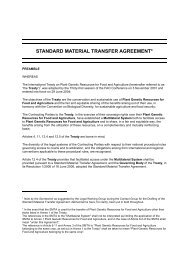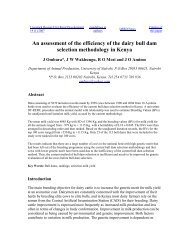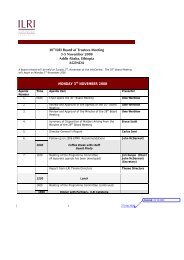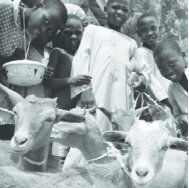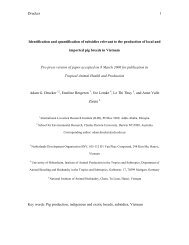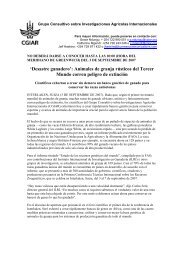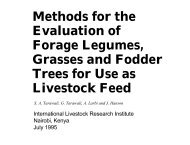Abstracts of Thesis Completed by ILRI Graduate Fellows 2007- PhD ...
Abstracts of Thesis Completed by ILRI Graduate Fellows 2007- PhD ...
Abstracts of Thesis Completed by ILRI Graduate Fellows 2007- PhD ...
You also want an ePaper? Increase the reach of your titles
YUMPU automatically turns print PDFs into web optimized ePapers that Google loves.
<strong>Abstracts</strong> <strong>of</strong> <strong>Thesis</strong> <strong>Completed</strong> <strong>by</strong> <strong>ILRI</strong> <strong>Graduate</strong> <strong>Fellows</strong> <strong>2007</strong>- <strong>PhD</strong>1. The Dynamics <strong>of</strong> Savanna Ecosystems and Management in Borana, Southern Ethiopia.Norwegian University <strong>of</strong> Life Science, Norway. Ayana AngassaAbstract: Department <strong>of</strong> International Environment and Development Studies, NORAGRIC,Norwegian University <strong>of</strong> Life Sciences (UMB).This thesis discusses the dynamics <strong>of</strong> savannaecosystems and management in southern Ethiopia <strong>by</strong> investigating the roles played <strong>by</strong> rainfallvariability and the impact on cattle population under the communal rangelands and ranch system.The thesis considers the variability in terms <strong>of</strong> impact <strong>of</strong> multi-year droughts on livestock <strong>of</strong> differentreproductive classes and their recovery patterns, comparing the traditional and ranch managementsystems. The thesis also investigates the importance <strong>of</strong> using herder environmental knowledge inunderstanding historical changes in patterns <strong>of</strong> land use and shifts in vegetation, with implications forpastoral production. Using herder concerns about shifts in grassland vegetation to bushencroachment, the thesis presents studies that examine the ecological mechanisms <strong>of</strong> bushencroachment in relation to protection, grazing and time <strong>of</strong> protection. The studies demonstrate thecontrol <strong>of</strong> bush encroachment and evaluate the responses <strong>of</strong> individual woody and herbaceousspecies using six demonstrations.This study is based on ecological models, focusing on the equilibrium and non-equilibrium models.The thesis seeks to understand the drivers <strong>of</strong> change behind cattle population variability,mechanisms <strong>of</strong> bush encroachment and effects <strong>of</strong> control demonstrations on woody and herbaceousplant species in Borana. Traditionally, the Borana land use system involves extensive livestockproduction based on mobility between the key and non-key resources. The thesis uses householdinterview and field based data collected between 2002 and 2005. Household cattle data (21 years) andthe ranch cattle data (15 years) were related to long-term rainfall variability.Breeding cows in the key resource tula well rangelands showed longer reproductive life than the nonkeyresource pond-water rangelands. Average calving rates were greater in the communal range landsthan in the ranch system. Severe mortality and greater reduction in calving rates during multipledroughts resulted in reduced herd growth potential. Inter-annual variability in rainfall seems to have aconsiderable effect on cattle populations compared to density dependence. The combined effects <strong>of</strong>variable rainfall and increased bush cover might lead to risks <strong>of</strong> drought induced herd die <strong>of</strong>fs.Specifically, herder perceptions indicated that the emergence <strong>of</strong> range enclosures and expansion <strong>of</strong>crop farming have reduced the extent <strong>of</strong> grazing, while fire suppression has promoted bushencroachment.Furthermore, the study found greater densities <strong>of</strong> invasive woody species in enclosures as opposed tothe open grazed areas. This implies that additional causes might be involved in the process <strong>of</strong> bushencroachment apart from grazing. The use <strong>of</strong> the state-and-transition model showed complexsuccessional pathways <strong>of</strong> changes with regard to variability in rainfall, management interventions andtimescales (i.e. the age chronosequence <strong>of</strong> enclosures) that are relevant for making managementdecisions.The thesis suggests that protection from disturbance promotes bush encroachment. It was foundthat four out <strong>of</strong> the six bush control methods substantially reduced bushy plants, with varied effectson individual species. Overall, the tree cutting, fire and grazing treatment was more effective incontrolling coppicing after disturbance. Different woody species showed varied adaptation strategiesin response to disturbances <strong>by</strong> either adapting to increased seedling recruitment or coppicing afterdisturbance. The disturbance control treatment had no advantage in terms <strong>of</strong> herbaceous biomassand basal cover over other treatments, while herbaceous species richness was enhanced. This thesissuggests that grazing with bush cover greatly reduces herbaceous biomass. Generally, tree cutting and1
fire seemed superior in terms <strong>of</strong> herbaceous biomass, while fire and grazing, and tree cutting arerecommended for the conservation <strong>of</strong> herbaceous species diversity. The outcomes in terms <strong>of</strong>herbaceous biomass and species diversity have important policy implications for bush encroachmentcontrol and public education. This thesis emphasizes the importance <strong>of</strong> the fire and grazing methodwhich can reasonably be recommended for control <strong>of</strong> bush encroachment with the overall objective<strong>of</strong> promoting herbaceous biomass and species diversity.Results presented in this thesis suggest the following views: (i) The study acknowledges the evidence<strong>of</strong> density dependence at the level <strong>of</strong> local land use, but overall density independence at the regionallevel. The findings further confirm the failure <strong>of</strong> ranch management in reducing herd mortality andsignify the role <strong>of</strong> rainfall variability even under a controlled system. The need for droughtmanagement, focusing on post-drought herd rehabilitation through the distribution <strong>of</strong> bulls, dependson the breed conservation ranch and is important for the maintenance <strong>of</strong> the Borana cattle breed; (ii)The use <strong>of</strong> communities’ environmental knowledge as a framework for understanding the impacts <strong>of</strong>land use change on the environment, may provide a strong foundation on which to reconstructscientifically and culturally acceptable methodological approaches. Sustainable use <strong>of</strong> the savannas <strong>of</strong>southern Ethiopia in the future will require paying greater attention to regulating expansion <strong>of</strong>enclosures, crop farming and ranching, as well as re-introducing fire, where necessary, to controlbush encroachment; (iii) The state-and-transition model is appropriate for describing the mechanisms<strong>of</strong> bush encroachment; (iv) Responses <strong>of</strong> individual woody and herbaceous species to bush controlmethods have important implications for management, conservation policy and public educationwhich in the future should be promoted through public education and extension.2. Economic Analysis <strong>of</strong> Trypanocide use in Villages under Risk <strong>of</strong> Drug Resistance in West Africa.University <strong>of</strong> Hanover. Hippolyte D. AffognonAbstract: Economic analysis can assist in the understanding <strong>of</strong> the factors that determine the success<strong>of</strong> trypanosomosis control <strong>by</strong> cattle farmers in the cotton zone <strong>of</strong> West Africa. Trypanocides are themost widely used method <strong>of</strong> control, and determining their short- and long-term productivityprovides important information. However, this must be interpreted in the light <strong>of</strong> emerging drugresistance, which poses a major obstacle to the sustainability <strong>of</strong> drug use. More generally, thisresearch aims to advance the methodology <strong>of</strong> measuring the productivity <strong>of</strong> animal disease controlinputs in West African cattle production. The study includes an empirical assessment <strong>of</strong> theproductivity <strong>of</strong> trypanocidal drugs and the costs <strong>of</strong> trypanosomosis under village conditions. Theanalysis was extended to capture the implications for the livelihood <strong>of</strong> the poor cattle farmers <strong>of</strong> adeclining susceptibility <strong>of</strong> trypanosomes to drugs. The results <strong>of</strong> this research can help decisionmakersto put in place strategies for improved management <strong>of</strong> trypanosomosis and trypanocidal drugresistance.The study was conducted in Burkina Faso and Mali from June 2003 to May 2004. Data werecollected <strong>by</strong> a team <strong>of</strong> veterinary epidemiologists, technicians and agro-economists. In all, 206 herdswith a total <strong>of</strong> 3565 cattle in eighteen villages were monitored during a period <strong>of</strong> twelve months.Input and output data were collected <strong>by</strong> enumerators posted in villages for which epidemiologicalconditions were assessed throughout the study period. Additional price information was collected inlocal markets, abattoirs and through focus group discussions. It was found that cattle-keeping isimportant in both Mali and Burkina Faso; however, herds were larger in Mali. The smaller herd sizein the study area compared to other parts <strong>of</strong> sub-Saharan Africa and the higher ratio <strong>of</strong> draughtanimals to male adult cattle, especially in Burkina Faso, indicate a farming system more orientedtowards intensive use <strong>of</strong> draught animals in crop production. The majority <strong>of</strong> cattle farmers in thestudy area considered trypanosomosis the most important disease <strong>of</strong> cattle, and knowledge <strong>of</strong> thecause <strong>of</strong> trypanosomosis in the study zone was relatively high compared to other parts <strong>of</strong> sub-Saharan Africa. Farmers are aware <strong>of</strong> many strategies to control the disease. However, their preferred2
strategy is the use <strong>of</strong> trypanocidal drugs and the majority <strong>of</strong> treatments are given <strong>by</strong> cattle farmers,although this is not legal.In the methodology developed, livestock production is modelled as a process in which localresources and external inputs are used to generate multiple outputs such as milk, meat, draughtpower, and manure, and indirect outputs including the finance and insurance functions <strong>of</strong>maintaining cattle stocks. The study applies a production function framework and integrates adamage control function to quantify cattle production output losses as well as the productivity effect<strong>of</strong> trypanocide use under different epidemiological conditions. For the estimation <strong>of</strong> the productivity<strong>of</strong> disease control inputs, a conventional Cobb-Douglas production function and a modified Cobb-Douglas function that integrates a damage abatement function were specified.Dummy variables were used to capture the effects <strong>of</strong> disease prevalence and drug resistance, thustaking into account different epidemiological conditions. Three different specifications <strong>of</strong> theexponential damage control function were tested. The specification that includes two sources <strong>of</strong>damage from diseases provided the best fit and was used for comparison with the Cobb-Douglasproduction function in the analysis. The productivity estimates <strong>of</strong> trypanocides in this study showthat the damage control function provides consistently higher marginal productivity for bothtrypanocides (isometamidium and diminazene aceturate) in cattle production systems where disease iscommon and isometamidium resistance is high. However, the conventional Cobb-Douglasproduction function model shows that the productivity <strong>of</strong> trypanocidal drugs decreases in thesituation where trypanosomosis disease prevalence and drug resistance are both high. The resultssuggest that treating the damage control inputs such as trypanocides in cattle production, as yieldincreasinginputs in the conventional framework is likely to generate misleading results.The marginal value products <strong>of</strong> isometamidium in all epidemiological conditions, and the marginalvalue product <strong>of</strong> diminazene in high-prevalence-high-resistance conditions, reveal an underuse <strong>of</strong>trypanocidal drugs. In a strict economic interpretation, this implies that in the short term cattlefarmers could increase the pr<strong>of</strong>itability in those conditions if they increase trypanocide input beyondcurrent levels. On the other hand, the static analysis applied in this study does not take into accountthe negative externality <strong>of</strong> trypanocide resistance in the future.If the use <strong>of</strong> trypanocide increases, cattle farmers will also be more likely to experience future lossesfrom trypanocide resistance. To delay and even reverse the development <strong>of</strong> resistance the concept <strong>of</strong>“rational drug use” is recommended. Using drugs rationally entails: reducing need for drugs <strong>by</strong>disease prevention strategies; decreasing use <strong>of</strong> drugs <strong>by</strong> replacing with alternatives; ensuring drugsare given only when clinically needed; giving the appropriate drug at the appropriate dose; andensuring correct administration <strong>of</strong> the drug.This study confirms that trypanosomosis is an important disease in the cotton zone <strong>of</strong> West Africa.Although drug resistance is increasing, trypanocidal drugs used are still effective against the disease.However, at the current sub-optimal level <strong>of</strong> isometamidium use, output losses are much higher –9.8% to 22.7% <strong>of</strong> the value <strong>of</strong> output – than in a situation where isometamidium use is optimal forthe epidemiological conditions. When disease control effort reaches the optimum level, output lossesare much lower in all epidemiological conditions (1.3% to 1.5% <strong>of</strong> output). At the current use <strong>of</strong>trypanocidal drugs, economic losses due to trypanosomosis range from €9.50 to €22.00 per TLU1and year.The costs <strong>of</strong> trypanosomosis at the current level <strong>of</strong> disease control effort, which include the controlcosts and the remaining loss after control are higher than they would be if isometamidium use was atoptimal levels, in all epidemiological conditions. Currently, trypanosomosis disease costs cattlefarmers €13.30 to €26.00 per TLU and year; however, at optimal disease control efforts, costs would3
e reduced to €8.60 to €10.10 per TLU and year, depending on epidemiological conditions. While thecurrent costs <strong>of</strong> the disease represent on average 12% to 28% <strong>of</strong> the output derived from cattleproduction in the study area, costs <strong>of</strong> the disease at optimal drug usage would represent only 7% to8% <strong>of</strong> output depending on disease prevalence and drug resistance levels. Lower costs <strong>of</strong> the diseaseand the increasing productivity <strong>of</strong> trypanocide in conditions <strong>of</strong> high drug resistance may create anintractable situation in which cattle farmers’ choices for trypanosomosis control measures are guided<strong>by</strong> the phenomenon <strong>of</strong> path dependency. Once this occurs, the only options for controlling thedisease would be the discovery <strong>of</strong> new drugs, for which the development is prohibitively expensive,or eradication <strong>of</strong> the tsetse vector <strong>of</strong> trypanosomosis – a strategy that has never been sustainablewithout considerable external support. Maintaining the effectiveness <strong>of</strong> trypanocides is hence apriority for farming systems in West Africa.The study has demonstrated the feasibility <strong>of</strong> applying the damage control framework for measuringthe productivity <strong>of</strong> animal disease control inputs at farm level in poor African countries. The modeldeveloped here concentrates on the direct effects <strong>of</strong> the disease, while the dynamic aspects <strong>of</strong> drugresistance are included in the model a simplified manner only. To capture these dynamic processesfurther research is required for example to develop a bioeconomic model that integrates the impacts<strong>of</strong> trypanosomosis on cattle farmers’ livelihoods and adequately captures the biological process <strong>of</strong>drug resistance.Keywords: Trypanosomosis, trypanocidal drug resistance, productivity, output losses, disease costs.3. Fragmentation and Settlement Pattern in Maasailand Implications for Pastoral Mobility, DroughtVenerability, and Wildlife: Conservation in an East African Savanna. Colorado State University,Colorado. Worden, J.S.Abstract - Fragmentation through land privatization and sedentarization impacts the conservationand management <strong>of</strong> grazing systems around the world. In this study Iexamine how rangelandfragmentation and the loss <strong>of</strong> key resource areas impact thestructure and function <strong>of</strong> the pastoralgrazing system and the implications for large wildherbivore (wildlife) distribution and abundance. Iused a land tenure and sedentarization gradient in the Greater Amboseli Ecosystem (GAE) <strong>of</strong>Kajiado District, Kenya to quantify the effects <strong>of</strong> fragmentation on patterns <strong>of</strong> pastoral settlement,livestock mobility and drought vulnerability at multiple spatial and temporal scales. I developed a newhigh resolution aerial counting technique to examine both broad and fine scale responses <strong>of</strong> wildlifeto fragmentation and pastoral settlements, and the loss <strong>of</strong> key resource areas to agriculture andconservation. Fragmentation has led to a fundamental transformation <strong>of</strong> pastoral settlement andgrazing patterns in the GAE. Formerly flexible settlement systems have been replaced with dispersedand clustered patterns <strong>of</strong> settlement in privatized and collectively managed areas respectively.Seasonal grazing patterns have moved from a wet to a dry season dispersal system as forageavailability replaced water distribution as a fundamental constraint. Livestock in highly fragmentedareas moved less under normal rainfall conditions, but appeared to move earlier, and farther thantheir less fragmented neighbors under drought conditions. Analyses <strong>of</strong> broad scale livestockmovement over a two year period (1999 – 2000) revealed that livestock were not maximizing theiraccess to green forage biomass as indicated <strong>by</strong> NDVI. Increasing pastoral land-use intensity reducedwildlife biomass and differentially altered wildlife distribution patterns in relation to pastoralsettlements depending on body size and feeding strategy. Similarly, increasing agriculturaldevelopment in key resource areas reduced wildlife biomass and altered distributions relative topermanent water. Protection increased wildlife biomass and provided an important refuge for certainspecies, but some species were locally absent due to habitat changes associated with elephantcompression. This study illustrates the importance <strong>of</strong> fragmentation in altering patterns <strong>of</strong> pastoralproduction and exacerbating vulnerability to extreme climatic events, and highlights the cascadingeffects these changes may have for wildlife conservation inside and outside protected areas.4
4. Grazing on the Edge: Competition, Conflict and Socio-Ecological Complexity in PastoralistHerding Strategies around Maasai Mara National Game Reserve, Kenya. Michigan StateUniversity, USA. Butt, B.Abstract: This study is concerned with the social, ecological, political and cultural dimensions <strong>of</strong>pastoral herding around the Maasai Mara National Reserve (MMNR) in south-western Kenya. Theresearch was aimed at uncovering the complexities inherent in the herding strategies <strong>of</strong> Maasaipastoralists and better understanding the relationships between the patterns <strong>of</strong> cattle mobility andboth the social and ecological processes influencing mobility. In particular, the study concentrates onfour areas <strong>of</strong> research: the effects <strong>of</strong> herd size on household relocation during drought periods;vegetation dynamics and the spatio-temporal variability <strong>of</strong> pastoral cattle activities on vegetation; theeffects <strong>of</strong> wealth on herding strategies <strong>of</strong> pastoralists; and the etiology <strong>of</strong> grazing conflicts betweenherders and protected area managers. The research used a wide variety <strong>of</strong> primary and secondary datasources to understand these four dimensions.The results <strong>of</strong> the study suggest that pastoral household relocation reduces the stress faced <strong>by</strong>pastoralists during the drought <strong>by</strong> lowering the average total daily distance and time, directing cattletowards the interior <strong>of</strong> the MMNR and concentrating the direction towards distinct grazing zonesinside the Reserve. In addition, the study also found that as grazing intensity increases, meangrassland vegetation indices decrease during the wet season, remain stable in the dry season, andincrease in the drought season. The spatial location <strong>of</strong> high intensity areas differ <strong>by</strong> season anddemonstrate that cattle intensively use different parts <strong>of</strong> the landscape at different time periods.These findings demonstrate remarkable resiliency within the pastoral livelihood system in adapting tochanging environmental conditions. However, the results also suggest that wet season impacts arelikely to be greater than dry or drought periods. While conventional wisdom suggests that impacts arelikely to be greater during periods <strong>of</strong> high stress, this research suggests otherwise. Results <strong>of</strong> theanalysis on wealth and herding found that herding strategies were similar between all three wealthcategories during the wet and dry seasons, but vastly different during the drought. Finally, Idemonstrate that the rise and importance <strong>of</strong> tourism in and around the MMNR is largely responsiblefor the presence and continued exacerbation <strong>of</strong> conflicts between herders and protected areamanagers. The presence <strong>of</strong> cattle inside the MMNR results in tourist dissatisfaction and thusprotected area managers enforce an ideal <strong>of</strong> nature conservation that is devoid <strong>of</strong> cattle because <strong>of</strong>complaints <strong>by</strong> tourists and not because <strong>of</strong> the presumed environmental degradation caused <strong>by</strong> cattle.This research makes important methodological contributions to the study <strong>of</strong> pastoralists, livestockand the environment <strong>by</strong> demonstrating the efficacy <strong>of</strong> using low-cost GPS collars to track cattlemobility at fine scales <strong>of</strong> space and time, and in using mixed method research to better understandnature-society relationships. The theoretical contributions to the literature lie in determining whattype <strong>of</strong> ecology can be best inserted into the political ecology <strong>of</strong> pastoralism. In addition this researchhas demonstrated the resiliency and flexibility <strong>of</strong> pastoral livelihood systems at the finest scales <strong>of</strong>space and time. The policy implications <strong>of</strong> this study address the issue <strong>of</strong> extractive resource useinside protected areas as well as nature <strong>of</strong> coercive conservation tactics against pastoralists who resideat the periphery <strong>of</strong> a protected area.5. Indigenous Selection Criteria and Genetic Diversity in African long-horned Ankole Cattle, BokuUniversity. Ndumu, DeoAbstract - Findings in this thesis comprise a major part <strong>of</strong> a project implemented in 5 countriesaround the African great lakes, entitled 'Indigenous selection criteria and genetic diversity in theAfrican Ankole Longhorn cattle".From one <strong>of</strong> a series <strong>of</strong> surveys, this thesis details the surveyundertaken to describe the production systems and document the indigenous selection criteria <strong>of</strong> the5
livestock keepers for the Ankole cattle genetic resource, in 4 countries <strong>of</strong> the African Great Lakesregion <strong>of</strong> Burundi, Rwanda, Tanzania and Uganda. In addition, the thesis details two experimentsaimed at testing a novel tool <strong>of</strong> 'phenotypic ranking' through the elicitation <strong>of</strong> cattle keepers' traitpreferences in breeding animals. Furthermore, the study provided vital inputs and laying foundationsfor sound decision making about breed conservation, use and development strategies for this cattlegenetic resource through an evaluation <strong>of</strong> regional differences in morphology and genotype <strong>of</strong> theAnkole cattle, in relation to spatial distances. The latter provides information on the genetic variation<strong>of</strong> the breed and therefore the breeding goals / selection preferences. The survey results show that inBurundi, Rwanda and the SW highlands <strong>of</strong> Uganda, cattle keepers are entirely sedentary and ownsmall herds. Elsewhere, Ankole cattle are herded in large numbers, with sporadic climate-dictatedmovement away from base at certain times <strong>of</strong> the year- a form <strong>of</strong> sedentary to seminomadic system.Milk is the main product in all areas, and is partly consumed at home and partly sold. Although theproduction systems vary across the regions/countries, in many aspects, the selection criteria for cowsare similar. Production traits like milk yield, fertility and body size were highly ranked. For bulls, thetrait "growth" was highly ranked in all study areas. Phenotypic features (coat colour, horn shape andsize) and ancestral information are more important in bulls than in cows. The only adaptive traitmentioned <strong>by</strong> livestock keepers was disease resistance. In areas where land was scarce (Burundi,Rwanda, SW Uganda) a clear trend <strong>of</strong> systematic change from keeping <strong>of</strong> pure Ankole cattle to crossbredanimals was observed. Results <strong>of</strong> a related study used to assess the new tool <strong>of</strong> 'phenotypicranking' corroborate the latter findings among the pastoralist <strong>of</strong> SW Uganda. The two experimentsemployed 41 body measurements taken from 15 bulls and 35 cows to describe in detail theirphenotypic characteristics. In experiment 1,12 groups <strong>of</strong> 6 to 8 cattle keepers volunteered to rankseveral groups <strong>of</strong> 4-5 animals according to their preference for a breeding bull or cow based onphenotype alone, while in the second experiment the ranking was based on phenotype as in the firstexperiment, but in addition a hypothetical life history was provided to the volunteer cattle keepers.Each animal was randomly assigned one <strong>of</strong> a level <strong>of</strong> the 4 traits in ths history on each day <strong>of</strong>experiment. This history included milk yield (on own performance for cows and that <strong>of</strong> the dam forbulls), fertility <strong>of</strong> the animal and its sire as well as events <strong>of</strong> East Coast Fever, each at two levels. Theanalyses employed the Generalized Multinomial Logit Models that were compared on basis <strong>of</strong> thelikelihood-based pseudo R-squares. The results indicated that cattle keepers were quite rational andpreferred cows <strong>of</strong> good production traits. On the other hand, the phenotypic appearance <strong>of</strong> bulls iscrucial in selection decisions <strong>of</strong> the cattle keepers. Individual fertility is main criteria for selectingcows, followed <strong>by</strong> milk performance, while, resistance to East Coast Fever was <strong>of</strong> highest importancein bulls. In both sexes, a dark red coat colour was highly rated. The study also indicates that themethodology <strong>of</strong> 'phenotypic ranking' combining phenotype and a hypothetical life history can beapplied elsewhere and can provide insights into the indigenous selection criteria used <strong>by</strong> the stockowners. Genetic and morphological characterisation was undertaken on almost all <strong>of</strong> the ecotypesrepresenting the African Ankole Longhorn cattle in 11 regional subpopulations located in 5 countriesaround the great lakes region, namely, Burundi, Rwanda, Tanzania Uganda and the DR Congo. Atotal <strong>of</strong> 472 individual animals were genotyped across 15 DNA microsatellite loci. 443 <strong>of</strong> these weremorphometrically measured on an array <strong>of</strong> 21 phenotypic descriptors <strong>of</strong> morphology. The traits thatshowed largest variation proportion attributed to region were femoral thigh length, horn length, hornbase circumference, rump height, body length, height at withers and the fore limb circumference. Anoverall regional Fst index indicated that 2.7% <strong>of</strong> the genetic variation is attributable to differencesamong sub-populations. The least differentiation was observed between the two sub-populations <strong>of</strong>Mbarara south and Luwero in Uganda while the most differentiated were Mugamba in Burundi andMalagarasi in Tanzania. An estimated membership <strong>of</strong> four (4) for the inferred clusters from a modelbased Bayesian approach was obtained. Both distance - based and model-based analyses methodsconsistently isolated the Mugamba sub-population in Burundi from the rest. This coupled with a loweffective sub-population size and high Fis value, suggests that conservation measures for this subpopulationmight be warranted. The results from morphometric (shape and size), genotypic andspatial distance data were compared on a mantel test; high correlation was noted between6
and individualization <strong>of</strong> social relations, but not necessarily leads to deepening rural factor marketsand stimulating local employment opportunities. Under such situations, markets remainunderdeveloped and fail to become a driving force for agricultural transformation in rural Africa. Thecase studies suggested that both in South African and Kenyan rural communities the functionalinterdependence between households in productive farm and <strong>of</strong>f-farm activities was, and hasremained, weak, while individual households independently pursue livelihood portfolios extensivelydiversified into <strong>of</strong>f-farm income sources. On the other hand, negative impacts <strong>of</strong> de-agrarianisationon rural development are more pronounced in rural South Africa than in rural Kenya especially inregard to the vulnerability <strong>of</strong> the poor to external shocks. While increasing social differentiation hasled to the shrinkage <strong>of</strong> the scope <strong>of</strong> the economy <strong>of</strong> affection, to which the poor might have beenable to resort in the past, the unemployed have even not afforded to practice subsistence farming. Incontrast, the Kenyan poor seem to have some more options for survival “outside the systems”, <strong>by</strong>retreating into subsistence or exploiting the nature surrounding them. However, survival strategies“outside the systems” <strong>by</strong> the poor raise serious governance concerns over common naturalresources, while increased population pressure is expected to intensify competitions for suchresources.In general, across rural Africa, the poor have been identified as lacking capital assets, especiallyhuman capital, to adopt high-return livelihood strategies in response to risks and economicopportunities provided <strong>by</strong> greater exposure to wider social dynamics. Yet, the fact that ruralhouseholds pursue diversified livelihood diversification portfolios may make the effectiveness <strong>of</strong>policy tools aimed at only the agriculture sector unpredictable. Instead, the following policyimplications are derived from the micro-level findings.First, rural poverty alleviation and promotion <strong>of</strong> sustainable agricultural development require meso-/macro-level policies encompassing the promotion <strong>of</strong> multi-sectoral development rather thanfocusing on agriculture. From a household/individual perspective, motivations to diversify incomesources include risk management and economies <strong>of</strong> scope. My findings in South Africa and Kenyahave shown that households diversifying into regular <strong>of</strong>f-farm income activities are more endowedwith human capital assets, especially education and skills, and also more likely to invest in agricultureand resource management. In contrast, households engaged in low-return casual <strong>of</strong>f-farm incomeactivities lack the assets necessary to undertake productive farming activities and thus have littleincentive to manage resources properly. Diversification into remunerative <strong>of</strong>f-farm activities appearto provide the necessary capital for farming and to reduce the risks arising from specialisation infarming. Therefore, meso-/macro-level development policies need to be multi-sectoral,encompassing education and farm and <strong>of</strong>f-farm activities.Second, community-level projects require effective targeting. Within a small community, householdsare sharing physical, natural capital. In turn, my findings have revealed that the increasing socialdifferentiation due to heterogeneous endowments in human and financial capital led to skewedaccess to and dependence on common natural resources among community members, while makingcustomary practices that used to ensure coordination among community members either incommunal work or in the management <strong>of</strong> common resources less binding and alienating the poorfrom the benefits arising from social capital. Projects aimed at enhancing the diversity andpr<strong>of</strong>itability <strong>of</strong> livelihood portfolios <strong>of</strong> the poor and at augmenting their capital asset bases may bemore effective than efforts solely focused upon restricting access to common resources, as is <strong>of</strong>tenthe case. Classifying households according to the dominant livelihood strategies in a particular localcontext can serve for efficient targeting.In concluding this study, I stress the importance <strong>of</strong> more inductive research on rural Africanlivelihoods. As rural livelihoods in Africa have been continuously changing, rather than searching fordeductive models, inductive studies can not only facilitate the analysis <strong>of</strong> social changes from the8
perspective <strong>of</strong> households/individuals but will fill the empty spots in the knowledge <strong>of</strong> developmentand enrich models.7. Reproductive and Lactation Performance <strong>of</strong> Dairy Cattlein the Oromiya Central High lands <strong>of</strong>Ethiopia (With Special Emphasis on Pregnancy Period). ). Sweden, SLU. Fikre LobangoAbstract: This thesis presents studies <strong>of</strong> the reproductive and lactation performance <strong>of</strong> dairy cattle inthe Oromiya central highlands <strong>of</strong> Ethiopia, with particular emphasis on diagnosing and monitoringpregnancy. In an introductory study, early abortions were induced in four heifers with cloprostenoland monitored using ultrasonography. Prior to cloprostenol injection, plasma concentrations <strong>of</strong>bovine pregnancy-associated glycoprotein 1 (bPAG1), prostaglandin F2a (PG metabolite), andprogesterone (P4) varied from 8.4-40 ng/mL, 158-275 pmol/L and 20.7-46.9 nmo1, respectively.After foetal death and subsequent explosion, the bPAG1 level began to decrease, though thedecrease was small and gradual. The PG metabolite level started to display short lasting peaks withinthree hours, while the P4 level dropped sharply. A cross-sectional study was followed <strong>by</strong> two years <strong>of</strong>longitudinal observation to examine the reproductive and lactation performance <strong>of</strong> smallholder dairycows in Selalle, central Ethiopia: these studies involved300 and 24 randomly selected smallholderdairy farms, respectively.The geometric means <strong>of</strong> the calving-to-conception interval (CCI) and duration after the last calvingas determined in the cross-sectional study were 187 and 201 days in pregnant and non pregnantcows, respectively. While the means <strong>of</strong> calving interval (CI), CCI and 516,253 and141 daysrespectively. Production system, district (location) and suckling status influenced these intervalsconsiderably. Based on milk P4 pr<strong>of</strong>iles, the mean first onset <strong>of</strong> luteal activity (OLA) after calvingwas 52 days and was significantly influenced <strong>by</strong> suckling and parity number. The prevalence <strong>of</strong> preweaningcalf mortality was quite high, up to 17.4%. The mean lactation length was 54.4 weeks, whilethe mean milk yield for the first 43 weeks <strong>of</strong> lactation was 11.7 L/day for crossbred cows. Sucklingstatus, season <strong>of</strong> calving and parity number significantly influenced the daily milk yield. A furtherfollow-up study described the serum pr<strong>of</strong>iles <strong>of</strong> pregnancy-associated glycoprotein (PAG), oestronesulphate (EI-S), and P4 during gestation in both Borana and crossbred cattle. Accordingly, the PAGconcentrations at the fourth week post conception were 1.5-5.5 ng/mL and 2.1-4.7 ng?mLin Boranaand crossbred cattle, respectively, and increased progressively, peaking approximately at the time <strong>of</strong>calving. The serum El-S concentrations at the 17 th week <strong>of</strong> pregnancy were 0.3-2.6 and 0.9-5.7ng/mLin Borana and crossbred cattle respectively and increased progressively until calving. Breedparity status, dam body weight, foetal sex and foetal birth weight (only for PAG) significantlyinfluenced PAG and EI-S concentrations. The P4 concentrations at the 4 th week <strong>of</strong> pregnancywere3.2- 5.1 and 1.7-8.9 ng/mL in Borana and crossbred cattle respectively and remained elevatedthroughout gestation.In conclusion, the smallholder dairy cows in the study area experienced prolonged CCI and CI andthus, their reproductive performance was unsatisfactory. Moreover, the observed pre-weaning calfmortality rate is quite high. The serum PAG and P4 levels at the 4 th and the EI-S levels atapproximately the 17 th week <strong>of</strong> pregnancy were well above the required levels for pregnancy testingin both Borana and crossbred cattle. Moreover, the observed serum pr<strong>of</strong>iles <strong>of</strong> PAG, EI-S, and P4through out gestation (and 10 weeks postpartum for PAG) were comparable to those reported forthe other breeds <strong>of</strong> cattle.9
8. Reproductive Traits in Ethiopian Male Goats (With Special Reference to Breed and Nutrition).Sweden, SLU. Yoseph Mekasha GebreAbstract: This thesis characterizes reproductive traits <strong>of</strong> Ethiopian male goats raised under extensivehusbandry and subjected to differential nutritional management. A total <strong>of</strong> 177 extensively managedindigenous bucks <strong>of</strong> 5 breeds (i.e. Arsi-Bale) [AB], central High lands [CH], Afar, Boran and Woito-Guji [WG] were selected following stratifies random sampling. This bucks were compared accordingto three age classes (
design sustainable breed improvement programs aimed at improving productivity, livestock keepers’preferred traits need to be integrated into the breeding objectives.The study examines cattle keeping households’ preferences for phenotypic cattle traits intrypanosomosis prevalent production systems if Kenya and Ethiopia, using cross-sectional choiceexperiment survey data <strong>of</strong> 5006 cattle keeping households collected between September 2004 andMay 2005. Further, it investigates potentially sustainable pathways <strong>by</strong> which the cattle keepinghouseholds can access improved genetic materials based on their cattle traits <strong>of</strong> preference. Mixedlogit and latent class models are employed to model preference behavior for cattle traits from thechoice experiment data with a focus on heterogeneity among cattle keeping households. Specifically,mixed logit model is employed to investigate existence <strong>of</strong> preference heterogeneity, while a latentclass model is used to investigate the existence <strong>of</strong> endogenous preference segmentation for cattletraits among the cattle keeping households.The results reveal significant preference heterogeneity among cattle keeping households. Goodtraction potential, fertility, trypanotolerance and reproduction performance are found to be the mostpreferred cattle traits. Traits related to beef and milk yield are ranked below these traits. Thefindings are particularly interesting because traditional economic analyses on livestock and cattlebreeding programs <strong>of</strong>ten focus on raising milk and meat productivity, with little emphasis on thenon-income traits such as traction potential and disease resistance programs besides beef and milkyield. The results <strong>of</strong> the latent class model indicate that the households’ preferences are clusteredaround the production systems under which cattle production takes place. Three distinct classes <strong>of</strong>cattle keeping households in the sample population emerge, each displaying differing preferences forthe same set <strong>of</strong> cattle traits. This indicates the importance <strong>of</strong> considering heterogeneity withinpopulation segments as it provides a useful framework for adapting breeding policy interventions tospecific producer segments.Additional results indicate that communal breeding initiatives provide important pathways throughwhich resources-poor cattle keepers can access genetically improved livestock. Factors that influencea households’ willingness to participate in such a collective action decision are analyzed using a binarylogit model. The results indicate that the probability <strong>of</strong> participating in a collective action decision isinfluenced <strong>by</strong> several socio-economics and location characteristics. High human population densityindicate that the probability <strong>of</strong> taking up collective action decision. Similarly, presence <strong>of</strong> adultfemales in the household as well as higher level <strong>of</strong> formal education and age <strong>of</strong> the head <strong>of</strong> thehousehold increases the likelihood <strong>of</strong> participation in a collective action initiative. This has importantimplications for communal livestock breeding initiatives since resource constrained cattle keepersmay not individually afford to purchase improved breeding bulls and may be willing to participate incommunal breeding initiatives in order to access improved genetic material.11



